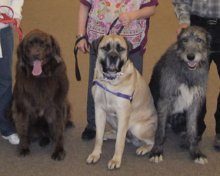 |
| The “biggest” therapy event featured more than 450 pounds of dog at one time. |
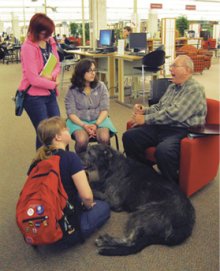 |
| A group of students enjoys hearing stories about the Irish Wolfhound breed. |
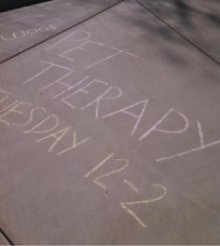 |
| Sidewalk chalk outside Andersen Library announces the therapy dogs’ impending arrival. |
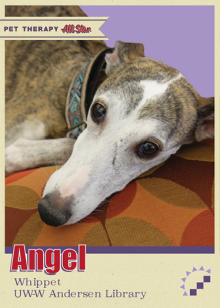
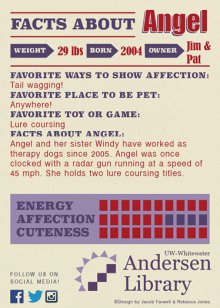 |
| A New Way to Connect: Trading Cards |
| All photos by Rebecca Jones |
Libraries have been hosting pet-therapy programs to relax their visitors for years. There are a multitude of examples in libraries big and small, public and academic, and everything in between. Programs really started to pop up around 2011, in libraries such as the Yale Law Library (http://bit.ly/1LT8aT7), the University of Connecticut’s, the Massachusetts Institute of Technology’s, and the Oshkosh Public Library (http://bit.ly/1JTYnI5). While these early adopters were quick to publicize their success, many libraries were a bit slower to get started and are just now beginning similar programs. Andersen Library, where I work, started in fall 2012.
The University of Wisconsin–Whitewater is a 4-year campus of approximately 12,000 students in southeastern Wisconsin. The student body is predominantly undergraduates, with just more than 1,000 graduate students. Andersen is the sole library on campus and is heavily used, seeing 4,000-plus visitors a day during its busiest times.
The library has seen a drastic uptick in gate count and checkouts in the last 8 years. These increases are due to changes made by the director who took over in 2008 and worked to modernize our environment, collections, and services. Before I was hired as a full-time public relations and event coordinator, programming at Andersen Library was essentially nonexistent. Since then, we have worked with other departments on campus to develop a full schedule of programs, such as resume review services, “Maker Monday” activities, finals relaxation events, speakers, book clubs, and more.
We were already focusing on our heavily stressed students during exam time by providing free popcorn and coffee and by extending our hours. The free food was a huge hit, and campus tour guides even touted it during tours for prospective students. We looked for new ways to help our students relax. We quickly added coloring pages, crafts, contests, card-making, and a graffiti wall for students to write comments and draw on. Soon, we were going through roughly 1,000 coloring pages each finals period. In addition to focusing on mental health with programming, we have also added yoga balls and a treadmill desk for students to use while studying.
Upon hearing rumblings of elite university libraries around the country integrating pet therapy into their end-of-semester stress-reduction efforts, we were interested in bringing the idea to UW-Whitewater. In late 2011, I began to research how to start such a program. While the director was on board, library managers were concerned that animals would be distracting to other students who were studying, that there were too many barriers in getting it started, and that it was too far afield from the library’s mission. These concerns slowed us down, but once an opportunity presented itself, we took it. In fall 2012, by a complete stroke of luck, a UW faculty member reached out to one of our reference librarians to let us know that she and her dog had been certified for pet therapy and were looking for a place to volunteer. While that got us moving, we still needed to talk to our campus’ risk management office to find out how to make this happen.
As per campus policy, dogs are not generally allowed on the grounds, so we needed to do some legwork to get everything approved. Our initial faculty member was certified through Therapy Dogs International (TDI; www.tdi-dog.org). We learned that TDI members and their dogs are covered by the organization’s insurance, which satisfied our risk management office’s need for insurance coverage. Risk management also wanted to see vet records from the owners and required us to tell owners that animals had to be on leashes at all times and had to be picked up after. In turn, we had to let risk management and the campus police know beforehand when the events would take place. Our initial volunteer even recruited a second faculty volunteer and therapy dog to get us started. Both dog owners were comfortable with these requirements, and we were able to set them up for their first therapy sessions.
Our First Promotions and Events
During the first semester of pet-therapy programming in fall 2012, we encouraged student attendance by promoting the dogs’ visits along with the other relaxation events we’d scheduled during final exams. Publicity included posters, social media postings, tabletop signage, and written notices on our whiteboard at the front of the library.
On the morning of our first event, we set up chairs for the volunteers and students just inside the library’s front entrance. This space is very open and allows for the dogs to remain in an area that is highly visible to entering patrons. This helped to generate interest. As the dogs arrived, so did the students! Many of them sat down and made themselves at home, some for the full 2-hour event. This initial visit drew in crowds of as many as 20 students at one time. The kids sat in a large circle, and the black lab and golden retriever moved around the center to greet them all.
Due to the overwhelming success of our first event, we were able to add more visits during the next semester. Because we had just two volunteers, we were tied to their availability, which limited us to just a few visits a month. We continued to promote them via social media, the whiteboard, and posters, and we set up our pet-therapy area early and put up a large poster announcing when the dogs would be there.
As the spring semester came to a close, our second volunteer notified us of a career move that took her out of the area. We were forced to look elsewhere for assistance. I spoke to a staff member at our campus’ center for students with disabilities who connected me with a network of volunteers across the state. After I contacted the coordinator of Bark River Pet Therapy, he added Andersen Library to a list of organizations that was seeking pet therapy. In the following months, people from Bark River contacted me to get started. We quickly were able to add five more dedicated volunteers.
Adding More Visits to Satisfy Students’ Needs
Since that first session in December 2012, we’ve increased the number of pet-therapy events each semester. During the 2014–2015 academic year, we held about 25 sessions each semester. Students have been loving the events and asking when the dogs would be in next. So we’ve continued to look for new ways to improve our promotion and events and to continuously monitor student opinion.
In 2014, we began having student employees go out the evening before or morning of the events to “chalk” the sidewalks around the library announcing the dogs’ impending arrival. The students drew paw prints along with the time and date and a few random “woofs.” We took photos of these drawings and posted them to social media to get students excited. We added a full schedule of the therapy dates and times (along with photos) to our computer desktops’ images to help get the word out to all our current patrons.
By this point, the pet-therapy program had grown so much that it was well-known across campus. Tour guides talked about it when bringing prospective students through the library; students asked for more on our suggestion boards; and campus leaders across the university mentioned it regularly. With all of this positive recognition, we do not field any complaints or receive negative attention due to allergies or other issues with the animals. It was especially exciting to have a group of prospective students come into the library during a visit and take a break so all of the families could greet the dogs. They got to see the library when it was really active. While we haven’t surveyed students to see if they chose Whitewater for this reason, I wouldn’t be surprised if the campus gained a few new students this way!
A New Way to Connect: Trading Cards
During spring 2014, we began looking at new ways to promote the program to our students. The attendance was great, but many of the visitors were just stumbling across the event and were not coming to the library because the therapy dogs were in. While this was a nice surprise for them, we wanted to be more proactive in getting the word out and in giving students a fun way to learn about the program. After seeing a series of trading cards that staffers were using to promote the pet-therapy program at the University of Wisconsin–Stout’s library, we decided to promote our dogs in a similar manner. Our volunteers were enthusiastic about the plan and offered up ideas and photos for us to use.
One of our regular pet-therapy volunteers, communications department faculty member Carol Terracina-Hartman, contacted us to ask if she could use the trading cards as a project for her publication layout course. While this meant that our project would be delayed a semester, we were delighted to have student input and investment.
She asked for two informational meetings in which we would share our requirements with her class, answer questions, and brainstorm. We gave the students a chance to help decide what information to include on the cards. We wanted them to include our logo, our social media accounts, and the breed and name of the dog. Then students were able to do their own research, take their own photos, and come back the following week with more questions. This brainstorming was extremely helpful. It gave the library staffers a chance to see what information the students would find useful and interesting, and it allowed us to talk with students about the program.
The students had my contact information, thus we were able to continue the conversation outside of the classroom. This was to be a formal experience for them, the kind that they’d expect from a “real-life” client. The students then worked in groups of two to four to develop a trading card, a web banner, and a print poster. On the due date, students submitted their projects to their instructor and to me. I printed out all of the submissions and shared them with other members of our public relations committee and library management team. Our staff chose three designs that we thought would best meet our needs and also suggested ideas for making the designs even better. The final three were submitted again, and we selected a winner.
Toward Continual Improvement
During this fall 2015 semester, we will begin using the trading cards as a way to encourage students to watch out for our promotions and to keep coming back. To collect all 12 cards, students must visit the library during the scheduled therapy sessions. Rather than just putting the cards out for students to take all at once, we’ll give each volunteer a stack of cards that feature his or her own pet, and he or she will hand them out to students. This will make the cards somewhat of a collector’s item. We hope the pet-therapy trading cards will be a very successful tool to promote the events and to make students feel more connected to the dogs.
Even though our pet-therapy program has been very successful, we realize that we can always make it even better. Librarians can greatly benefit from branching out and implementing new programs for their patrons. New events may not always turn out perfectly the first time, but with every attempt, we learn more about our community and about how to better reach and serve our patrons.
|